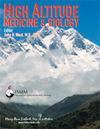缺氧诱导的心肌肥大与细胞凋亡增强和 p38-MAPK 通路激活有关。
IF 1.6
4区 医学
Q4 BIOPHYSICS
引用次数: 0
摘要
李晓旭、蒲志军、徐刚、杨一东、崔宇、周晓颖、王晨媛、钟志峰、周思敏、尹俊、单法宝、杨成忠、焦莉、陈德伟、黄健。缺氧诱导的心肌肥厚伴细胞凋亡增强和p38-MAPK通路激活。High Alt Med Biol.背景:右心室功能和重塑与缺氧性肺动脉高压的症状严重程度和患者存活率密切相关。然而,缺氧诱导心肌肥厚的详细分子机制仍不清楚。研究方法以Sprague-Dawley大鼠为研究对象,在常氧和低压缺氧条件下,以7天(H7)、14天(H14)和28天(H28)为间隔评估血流动力学。用苏木精和伊红(HE)染色法检查心肌组织的形态变化,用小麦胚芽凝集素(WGA)染色法评估心肌肥厚。细胞凋亡通过 TUNEL 检测确定。为进一步了解心肌肥厚的机制,进行了 RNA 测序,并通过 Western 印迹分析验证了结果。结果研究表明,大鼠模型缺氧性肺动脉高压加重,右心室舒张和收缩功能改善。与对照组相比,H14 和 H28 组的肺动脉收缩压 (PASP)、肺动脉平均压 (mPAP)、右室平均压 (RVMP) 和 +dp/dtmax 的绝对值显著升高。此外,H28 组的右心室收缩压(RVSP)、-dp/dtmax 和等容舒张期的平均 dp/dt 也明显高于对照组。H14 组的心率增加,而 H14 和 H28 组的右心室等容松弛时间常数(tau)均降低。H14组和H28组的右心肥厚指数和心脏重量/体重比(HW/BW)均升高。HE 和 WGA 染色显示,心肌细胞横截面积也有所增加。Western 印迹结果显示,H7 组的 HIF-1α 水平上调,HIF-2α 表达增强。此外,H28 组中 p38 和 c-fos 的磷酸化也有所增加。H28 组的细胞色素 C(Cyto C)水平升高,而 H14 和 H28 组的裂解 Caspase-3 和 Bax/Bcl-2 比率水平升高。TUNEL分析表明,随着右心室缺氧时间的延长,细胞凋亡也在增加。结论:该研究确定了缺氧诱导的心肌肥厚中细胞凋亡和 p38-MAPK 通路激活之间的联系,表明它们在这一病理过程中起着重要作用。本文章由计算机程序翻译,如有差异,请以英文原文为准。
Hypoxia-Induced Myocardial Hypertrophy Companies with Apoptosis Enhancement and p38-MAPK Pathway Activation.
Li, Xiaoxu, Zhijun Pu, Gang Xu, Yidong Yang, Yu Cui, Xiaoying Zhou, Chenyuan Wang, Zhifeng Zhong, Simin Zhou, Jun Yin, Fabo Shan, Chengzhong Yang, Li Jiao, Dewei Chen, and Jian Huang. Hypoxia-induced myocardial hypertrophy companies with apoptosis enhancement and p38-MAPK pathway activation. High Alt Med Biol. 00:00-00, 2024. Background: Right ventricular function and remodeling are closely associated with symptom severity and patient survival in hypoxic pulmonary hypertension. However, the detailed molecular mechanisms underlying hypoxia-induced myocardial hypertrophy remain unclear. Methods: In Sprague-Dawley rats, hemodynamics were assessed under both normoxia and hypobaric hypoxia at intervals of 7 (H7), 14 (H14), and 28 (H28) days. Morphological changes in myocardial tissue were examined using hematoxylin and eosin (HE) staining, while myocardial hypertrophy was evaluated with wheat germ agglutinin (WGA) staining. Apoptosis was determined through TUNEL assays. To further understand the mechanism of myocardial hypertrophy, RNA sequencing was conducted, with findings validated via Western blot analysis. Results: The study demonstrated increased hypoxic pulmonary hypertension and improved right ventricular diastolic and systolic function in the rat models. Significant elevations in pulmonary arterial systolic pressure (PASP), mean pulmonary arterial pressure (mPAP), right ventricular mean pressure (RVMP), and the absolute value of +dp/dtmax were observed in the H14 and H28 groups compared with controls. In addition, right ventricular systolic pressure (RVSP), -dp/dtmax, and the mean dp/dt during isovolumetric relaxation period were notably higher in the H28 group. Heart rate increased in the H14 group, whereas the time constant of right ventricular isovolumic relaxation (tau) was reduced in both H14 and H28 groups. Both the right heart hypertrophy index and the heart weight/body weight ratio (HW/BW) were elevated in the H14 and H28 groups. Myocardial cell cross-sectional area also increased, as shown by HE and WGA staining. Western blot results revealed upregulated HIF-1α levels and enhanced HIF-2α expression in the H7 group. In addition, phosphorylation of p38 and c-fos was augmented in the H28 group. The H28 group showed elevated levels of Cytochrome C (Cyto C), whereas the H14 and H28 groups exhibited increased levels of Cleaved Caspase-3 and the Bax/Bcl-2 ratio. TUNEL analysis revealed a rise in apoptosis with the extension of hypoxia duration in the right ventricle. Conclusions: The study established a link between apoptosis and p38-MAPK pathway activation in hypoxia-induced myocardial hypertrophy, suggesting their significant roles in this pathological process.
求助全文
通过发布文献求助,成功后即可免费获取论文全文。
去求助
来源期刊

High altitude medicine & biology
医学-公共卫生、环境卫生与职业卫生
CiteScore
3.80
自引率
9.50%
发文量
44
审稿时长
>12 weeks
期刊介绍:
High Altitude Medicine & Biology is the only peer-reviewed journal covering the medical and biological issues that impact human life at high altitudes. The Journal delivers critical findings on the impact of high altitude on lung and heart disease, appetite and weight loss, pulmonary and cerebral edema, hypertension, dehydration, infertility, and other diseases. It covers the full spectrum of high altitude life sciences from pathology to human and animal ecology.
 求助内容:
求助内容: 应助结果提醒方式:
应助结果提醒方式:


